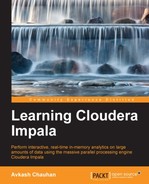Now, we will spend some time in understanding the query-specific SQL statements used in Impala. Most of these statements are exactly the same as they are defined in SQL, so to learn more, I would suggest you to look at any SQL reference documentation. Here, I am covering some key information for reference purposes:
- EXPLAIN: Using the
EXPLAINclause, we can learn the execution plan of a SQL statement by understanding low-level mechanisms that Impala will use to read and process the data in the whole cluster, and then finally show the results. You can use theEXPLAINclause ahead of aSELECTstatement as shown in the following example:[Hadoop.testdomain:21000] > EXPLAIN SELECT * FROM list; Explain query: select * from list PLAN FRAGMENT 0 PARTITION: UNPARTITIONED 1:EXCHANGE tuple ids: 0 PLAN FRAGMENT 1 PARTITION: RANDOM STREAM DATA SINK EXCHANGE ID: 1 UNPARTITIONED 0:SCAN HDFS table=default.list #partitions=0 size=0B tuple ids: 0 REFRESH table_name; - REFRESH: In a multimode environment, the data files reside on multiple DataNodes while the Impala shell is interacting with the Impala daemon (which acts as the data coordinator for all other nodes). Data files can be updated on other nodes without any update event or information to the coordinator. In this situation, using the
REFRESHclause with the table name loads the latest metadata and block location of the data files for a particular table.Please refer to Chapter 2, The Impala Shell Commands and Interface, to understand more on how
REFRESHworks and why it is so important to use. - JOIN: The
JOINclause is used in SQL statements to select data from two or more tables and then return the result set containing items from some of all of those tables, depending on the conditions applied. TheJOINquery result set is filtered by including the corresponding join column names in theONclause or by comparison operators referencing columns from both tables in theWHEREclause. To improveJOINperformance, here are some suggestions:- It is advisable to perform the
JOINoperation on the biggest table first and then smaller tables - Join subsequent tables depending on which table has the most selective filter
- It is advisable to perform the
..................Content has been hidden....................
You can't read the all page of ebook, please click here login for view all page.
